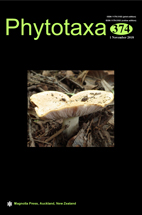Abstract
Tricholosporum haitangshanum sp. nov. is described as a new species from China, based on morphological and molecular data. It is morphologically characterized by a yellowish ochre pileus, cruciate basidiospores and ampullaceous cystidia. Phylogenetic analyses based on the nuc rDNA internal transcribed spacer (ITS) region supports that it belongs to Tricholosporum. Comparing it with phenotypically similar and molecular phylogenetically allied taxa concluded that it is a new species in Tricholosporum.

